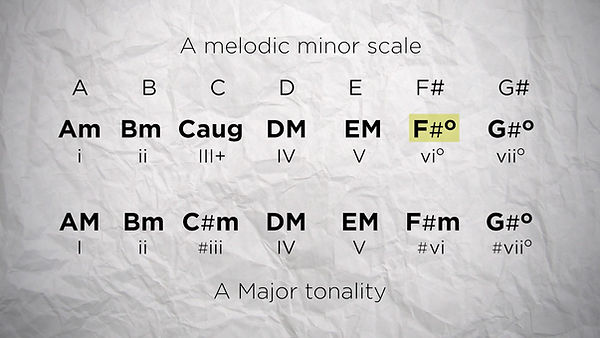
11. Substitutions & borrowings
Today we'll see how to include accidentals to our chord progressions. Accidentals are notes that are outside of the tonality we are using, which can be a good way to add some tension to our harmony and melodies, and adds different flavours and emotions.
A good way to implement an accidental is to use dominant chords, again. Just like we used them in the previous video about modulations. Taking advantage of the authentic cadence, you can momentarily consider any of your chord as a Ist degree, so you can play its Vth degree before it. So it would make a beautiful V to I progression.
For example, we are in CM (that's all the white keys on the keyboard) and we have this chord progression of CM Am Dm GM.

Then, for a moment, I can consider any of these chords, say the Dm, as the I. So I can add it's own V just before it, which is AM, or even A7 (the Vth degree of the D minor scale). And then I can go on with the tonality of CM I was in before, I don't have to stick with this Dm tonality.
Dm being the II degree of my tonality, A7 is then a V/II. It is borrowed from the tonality of that second degree (Dm).

This borrowing allows you to add some notes that are not in the original tonality you're using. This A7 chord is made of the notes A, C#, E and G. See, we're using a C# that is not normally in the CM scale.

So this kind of borrowing is super cool to add accidentals to your chord progressions, and you can add the Vth degree of any degree: V of II, V of III, V of IV, V of V, etc... allowing you to use a lot of notes that are not supposed to be in the tonality you're using.
But you can do more.
You can also borrow chord from a parallel tonality. Parallel tonalities are the major and minor tonality of the same key. So CM is parallel to Cm, DM is parallel to Dm, etc...
So at anytime you could replace any degree of the major scale by its equivalent of its minor scale.
For example in C Major, you could replace any chord of the C Major scale by its equivalent from the C minor scale.

In this case the CM could become a Cm,
The Dm could become a D diminished ,
The Em could become a EbM,
then this 3rd degree is noted bIII because the E became a Eb,
The FM could become a Fm
The GM could become a Gm
The Am could become a AbM
This 6th degree is then noted bVI as the A became a Ab
And the B diminished could become a BbM
Which is then noted bVII because the B became a Bb.
Note how the major chord are written with upper cases and the minor chords are written with lower cases with the roman numerals. It's juste a little simpler to say which chords are Major and which chords are minor.
In the same way if you come from the minor tonality, let's say Am to take the relative of CM, so all the white keys again,
The Am could become a AM
The B diminished could become a Bm
The CM could become a C#m
Which is noted #iii as the C became a C#
The Dm could become a DM
The Em could become a EM
The FM could become a F#m
Which us noted #vi because the F became a F#
And the GM could become a G# diminished
And this 7th degree is noted #viio as it became a G#

Note as well that these #vi and the #vii are also possible in the melodic minor scale as the melodic A minor scale also have a F# and a G#, but because the C stays natural the #vi would be diminished in these case.

So replacing a chord by another chord is called a substitution, and you can replace a chord by its equivalent of its parallel tonality.
But you can also do that with any mode. So, say you're in C Major, you could replace de E chord from the C Major scale by the E chord from the scale of C Dorian or C Phrygian for example.
But you can also make other types of substitutions.
And it all comes back to the authentic cadence again. You know when a Vth degree resolves to a Ist degree, I said that you could make this Vth degree a dominant 7 chord to emphasis the tension between the V and the I.
But you could also alter this Vth degree in several other ways.

You can make it a diminished 7 chord which will bring a new flavour to your chord progression.
So in CM the authentic cadence would go G7 to C. The notes that built the G7 chord are G B D and F. If you make it a G diminished 7 it becomes G Bb Db and Fb (which is the note E on the keyboard) so there, you are using the notes Bb and Db that are not in the CM scale.

But you could also make this V chord an augmented chord. So in this case a G augmented chord, which is made of G B and D#. There you are adding the D# that is not in the CM scale.

A third way of altering this Vth degree would be to use the tritonic substitution. Tritonic means 3 tones which was forbidden interval in the middle age, as it is very dissonant. It was even called the devil's interval to give you an idea. Anyways, this tritonic substitution is used a lot in jazz, for example.
Basically you replace the dominant 7 chord of your Vth degree by the dominant 7 chord a tritone away, so 3 tones higher or lower.
So in CM, you can replace your G7 by a Db7. If you count 3 tones up or down from G, you'll fall on a Db in both ways.
So the Db7 would be made of Db F Ab and Cb (which is the same note than B on the keyboard) so this chord would use the notes Db and Ab that are not in your CM scale.

This tritonic substitution works particularly well when you use the full authentic cadence ii V I, as it will become ii bII I, allowing your bass to do a chromatic descent that will sound amazing.
If the authentic cadence is the equivalent of a full stop in a sentence, then these substitutions give you a lot of options to finish your musical sentences.
So all those accidentals can be a good way to add different flavours to your chord progressions.
Next time we'll talk a bit about arrangement and voicing, the way the order of the notes of a chord affect the way we hear it, because we've talked a lot about different types of chord, so maybe it's time to talk a bit about some tips to get the best of them.